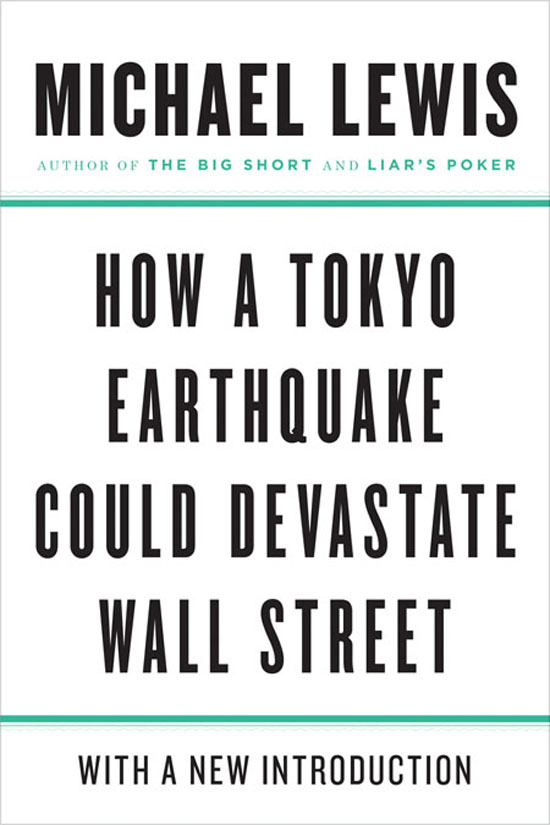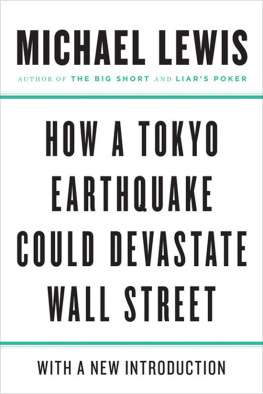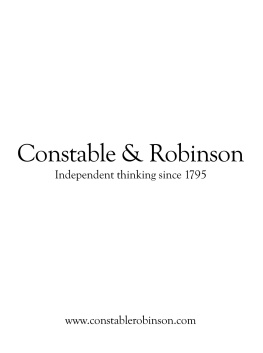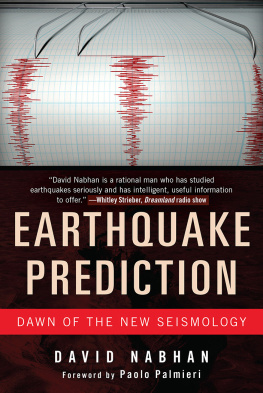
Copyright 2011, 1991 by Michael Lewis
All rights reserved
For information about permission to reproduce selections from this book, write to Permissions, W. W. Norton & Company, Inc., 500 Fifth Avenue, New York, NY 10110
For information about special discounts for bulk purchases, please contact W. W. Norton Special Sales at specialsales@wwnorton.com or 800-233-4830
Ebook conversion by Erin Schultz, TIPS Technical Publishing, Inc.
ISBN 978-0-393-34150-8
W. W. Norton & Company, Inc., 500 Fifth Avenue, New York, N.Y. 10110
www.wwnorton.com
W.W. Norton & Company Ltd., Castle House, 75/76 Wells Street, London W1T 3QT
In 1989, Michael Lewis reported on the potential effects of an earthquake in Japan on world financial markets. His insights are once again timely and are presented here as a stand-alone essay with a new introduction: Real Versus Imaginary Japanese Earthquakes.
In the late 1980s, Japanese scientists were trying to figure out the economic damage that would be caused if a catastrophic earthquake destroyed Tokyo. The answer was bleak, but not for Japan. Kaoru Oda, an economist who worked for Tokai Bank, speculated that the United States would end up paying the most. Why? Japan owned trillions of dollars worth of foreign liquid assets and investments. These assets, which the world depended on, would be sold, forcing countries into the precarious position of having to return large amounts of money they might not have. After the recent earthquake, Michael Lewis reexamined this hypothesis and came to a surprising conclusion. With his characteristic sense of humor and wit, Lewis, once again, explains the inner workings of a financial catastrophe.
How a Tokyo Earthquake Could Devastate Wall Street appears in Michael Lewiss book The Money Culture .
MICHAEL LEWIS is the best-selling author of Liars Poker, Moneyball, The Blind Side , and The Big Short . He lives in Berkeley, California, with his wife and three children.
I NTRODUCTION
Real Versus Imaginary
Japanese Earthquakes
Back in 1988 I left a job on Wall Street to write for a living. Amazed that magazine editors would pay me to travel anywhere in the world, so long as I could persuade them there was a story to be told about the place, I began casting around for stories about places I wanted to go. The first place I wanted to go was Japan. I proposed to a magazine editor a piece on what would happen in the world if Tokyo was destroyed by an earthquake. Of course, I had no idea what might happen if Tokyo was destroyed by an earthquake, and no clue how anyone would even begin to guess. But I found one of these incredibly generous characters called magazine editors and asked him to send me to Tokyo for a few weeks to... ponder the matter. And he did it.
The problem with this approach to the writing life, I soon found, is that at some point you need to write a story. What I had imagined more or less as a paid vacation in Tokyo soon became a sweaty search for an answer to what seemed even to me a preposterous question: what happens if this new center of global finance is wiped out? But I got lucky. It turned out that people inside Japanese government and finance had just begun to ask themselves the same preposterous question. An imaginative young geologist with Japans National Land Agency, named Hideaki Oda, had just finished a study in which he simulated a quake similar to the one that had destroyed Tokyo back in 1923 (and also in 1853, and in 1782, and in 1703 and in... ). Hed estimated loss of both life and property in various scenarios: time of day the quake occurred, weather conditions, etc. A smart Japanese economist named Kaoru Oda, who worked for the Tokai Bank in Nagoya, had used this report to estimate the earthquakes economic consequences.
The details of both reports were shocking. The first Mr. Oda, in his most likely scenario, described one hundred and fifty two thousand deaths, eight hundred thousand collapsed buildings, and about a trillion dollars in property damage. The second Mr. Oda forecast a dramatic rise of five percentage points in interest rates, and a collapse in economic growth rates and asset pricesall in the United States. That was the general picture that emerged from these mental exercises: when the next big one hit, the Japanese would suffer a great human loss but the financial pain would be felt mainly abroad, after Japan sold its foreign assets to pay for its reconstruction.
A nation living with a perpetually high risk of natural catastrophe had in effect bought itself a massive catastrophe insurance policy. The unwitting seller of that policy had been us.
There was a lot more in both reports than that, and I wont rehash it all here. But its interesting to compare what was imagined might happen twenty-three years ago with what actually is happening now. The real and imagined Tokyo earthquakes are different events: the real earthquake, though more severe than the imagined one, dealt Tokyo only a glancing blow; the financial losses caused by the real quake so far dont appear to be anything like a trillion dollars; and back in 1988 no one considered the possibility of nuclear disaster. The immediate financial market response to the actual event is also, at best, a first cousin to the scenario imagined back in 1988. In the fictional catastrophe the yen rose dramatically, as the Japanese government and private insurers sold all sorts of non-yen assets to buy yen, and it is rising now, for instance. But in the imagined scenario the Japanese stock market rose, in anticipation of a massive stimulus and a glorious economic future. Just now it is collapsing, spectacularly.
Theres a reason for the difference: the market has a lot less faith now than it did in 1988 in Japans economic future. The single biggest financial question to arise from the imagined scenario was: just how screwed will the United States be when Japan asks for its money back? It now has been joined by another: just how screwed will Japan be when it reveals that it not only wants, but needs, its money back?
That is what leaps out at you from the comparison of the real catastrophe to the imagined one: how different the context has become. Back in 1988 it was hard to imagine Japan working from anything but a position of strength: high savings rates, massive trade surpluses, a booming economy and stock market. There was no question then that Japan would bounce back. Today Japan feels almost doomed.
The ratio of Japans government debt to its GDP (209%) is the highest in the developed world, nearly double that of the next worst basket case, Greece. The Japanese government still owns roughly $900 billion of U.S. Treasury bonds, but less honestly. In effect, the Japanese government has borrowed huge sums from its own, increasingly strapped, people and used some of that money to fund U.S. Treasury bond purchases. The Japanese population, aging and shrinking, is saving less and less. The historically biggest buyers of Japanese government bonds, Japanese government pension plans, have recently become net sellers. The country has run through five ministers of finance in the last two years, and in ways that suggest the job has become a lot less appealing. (One left for health reasons, another appears to have committed suicide.)
The Dallas-based hedge fund Hayman Advisors, which has been betting that Japan will eventually need to default or restructure, has estimated that a mere three percent rise in interest rates would leave the government using all of its tax revenues simply to service its debt. Even before the earthquake, Japan, to balance its books, was probably going to need to sell a lot of government bonds to foreigners. And those foreigners probably were going to demand a far higher rate of interest than Japanese government pension plans do to hold them. That rate of interest just went up.
Next page














